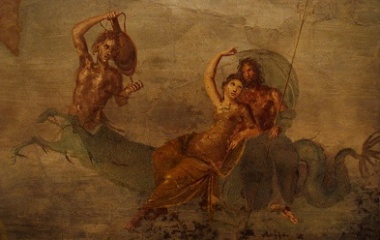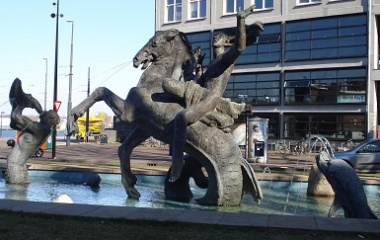Who is Amphitrite?
Greek mythological tales speak of the sea nymphs that assisted sailors facing storms on the sea. They lived deep in the Aegean Sea with their father Nereus, best known as the Old Man of the Sea, from Homeric passages. There are 50 Nereids in all, and the eldest is Amphitrite. She is a direct descendant, and granddaughter, of the primal titan Oceanus.
Originally, Amphitrite was an important goddess. She witnessed the birth of the god Apollo along with other high ranking deities. Her legendary husband was the powerful Poseidon, the god of the sea, and brother of the chief of gods, Zeus. In later years, she had a lesser role in the myths and eventually her name simply represented the sea itself.
Origin
The name Amphitrite means the third element, or the third that encompasses. In the creation myths, the heavens and the land came first before the sea.
She is often depicted wearing a crab claw crown and sitting on a throne near her husband Poseidon or in a chariot drawn by hippocamps, seahorses.
The story of her courtship with Poseidon started on the island called Naxos in the Aegean Sea. She was dancing with her sisters and when the god of the sea saw her, he decided he wanted her as his wife. Unfortunately, for the love-struck Poseidon, the goddess wasn’t interested in his proposal or giving up her life as a sea virgin and she ran off to the Atlas Mountains to hide.
Being the persistent type, Poseidon summoned Delphinus, the dolphin king, to find the goddess and persuade her to marry him. The smart and gentle natured dolphin set off on the mission. After weeks of searching, he finally found her. He was such a lovely creature that Amphitrite was drawn to him and listened to his persuasion. Delphinus explained that her steadiness would balance the volatile nature of Poseidon, and that if she married him there would be harmony in the sea and joy for all. As a reward, Poseidon placed an image of Delphinus in the sky.
Once they were actually married, the sea god went back to his usual ways and had numerous affairs with other goddesses, nymphs and mortals. Although she generally had a kind nature toward the creatures of the sea, the goddess was getting increasingly annoyed and jealous due to the extracurricular activities of her husband outside of their marriage. Particularly irritating to Amphitrite was his extreme infatuation with the beautiful sea nymph, Scylla. In a fit of jealousy, she tossed magic herbs into Scylla’s bath and the nymph changed into a terrible hideous monster with twelve arms and six mouths.
Scylla spent her days living in a cave and grabbing sailors as they passed with her long arms and eating them for lunch. Amphitrite rode off on her magical seahorse into the happily ever after of the ocean.
Family of Amphitrite
Nereus, the old man of the sea and lord of the fish, and his wife Doris had 50 daughters called the Nereid, meaning daughters of Nereus, derived from the word neros (wet). The eldest was Amphitrite, who had two children with Poseidon after they were married. Their children were Triton, who was a famous merman, and their daughter Rhode, who was a sea nymph.
Modern Influence
In later Greek mythology, the name Amphitrite became synonymous with the sea. Many ships in both the US and the British Royal Navy were named for her.
A painting by baroque artist Nicole Poussin completed in 1604 is called The Triumph of Amphitrite and depicts her marriage ceremony. It’s on view at the Philadelphia Museum of Art. There are several priceless works of art depicting Amphitrite’s image around the world, including a sculpture at the Louvre in Paris by Jacques Prou. There, she lounges with a dolphin while wearing her identifying crab claw crown.
We can also find the goddess above us in the stars. The large Asteroid 29 Amphitrite lies within the Aries constellation.
Wherever we find her, Amphitrite is a reminder of the wondrous and mysterious creatures, both real and mythological, that inhabit the seas.











yea yi love greek mythology and even though i dont like roman mythology a lot i still love this website. keep up the good work 😉
I love this lady! She is so cool! Even though I don’t believe in Greek Mythology, It’s still so cool to learn about what the Greek’s believed in!
Thank You for these insights – They are very helpful in my research of certain Goddess’s <3
this was very helpful, thank you
yes, this was a very helpful source for projects on greek mythology.